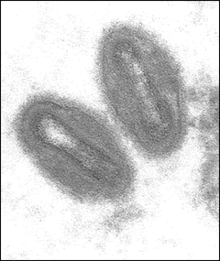- Monkeypox virus
-
Monkeypox virus 
Virus classification Group: Group I (dsDNA) Order: Unassigned Family: Poxviridae Subfamily: Chordopoxvirinae Genus: Orthopoxvirus Type species Vaccinia virus Species Monkeypox virus
Monkeypox virus is the virus that causes the disease monkeypox in both humans and animals. It was first identified in 1958 as a pathogen of crab-eating macaque monkeys (Macaca fascicularis) being used as laboratory animals. The crab-eating macaque is often used for neurological experiments. Monkeypox virus is an Orthopoxvirus, a genus of the family Poxviridae that contains other viral species that target mammals. The virus is mainly found in tropical rainforest regions of central and West Africa.
The virus was first discovered in monkeys (hence the name) in 1958, and in humans in 1970. Between 1970 and 1986, over 400 cases in humans were reported. Small viral outbreaks with a death rate in the range of 10% and a secondary human to human infection rate of about the same amount occur routinely in equatorial Central and West Africa.[1] The primary route of infection is thought to be contact with the infected animals or their bodily fluids.[1] The first reported outbreak in the United States occurred in 2003 in the midwestern states of Illinois, Indiana, and Wisconsin, with one occurrence in New Jersey. The outbreak was traced to pet prairie dogs infected from an imported African rodent. No deaths occurred.
The virus can spread both from animal to human and human to human. Infection from animal to human can be from an animal bite or direct contact with an infected animal’s bodily fluids. The virus can spread from person to person through both their breath and through contact with an infected person’s bodily fluids. Animal to human transmission is more common. The virus then incubates in the host for 10–14 days. Symptoms then start to show including swelling of lymph nodes, muscle pain, headache and fever. Sometimes a rash appears.
References
- ^ a b Meyer, H.; Mathilde Perrichot, Markus Stemmler, Petra Emmerich, Herbert Schmitz, Francis Varaine, Robert Shungu, Florimond Tshioko, and Pierre Formenty (2002). "Outbreaks of Disease Suspected of Being Due to Human Monkeypox Virus Infection in the Democratic Republic of Congo in 2001". Journal of Clinical Microbiology (American Society for Microbiology) 40 (8): 2919–2921. doi:10.1128/JCM.40.8.2919-2921.2002. PMC 120683. PMID 12149352. http://www.pubmedcentral.nih.gov/articlerender.fcgi?tool=pmcentrez&artid=120683. Retrieved 2008-03-22.
External links
- http://www.stanford.edu/group/virus/pox/2000/monkeypox_virus.html
- http://www.medicinenet.com/monkeypox/article.htm
Infectious skin disease: Viral cutaneous conditions, including viral exanthema (B00–B09, 050–059) HSV (Herpes simplex, Herpetic whitlow, Herpes gladiatorum, Herpetic keratoconjunctivitis, Herpetic sycosis, Neonatal herpes simplex, Herpes genitalis, Herpes labialis, Eczema herpeticum, Herpetiform esophagitis) · Herpes B virus (B virus infection)VZV (Chickenpox, Herpes zoster, Herpes zoster oticus, Ophthalmic zoster, Disseminated herpes zoster, Zoster-associated pain, Inflammatory skin lesions following zoster infection, Modified varicella-like syndrome)SealpoxOtherPapillomaviridaeHPV (Wart/Plantar wart, Heck's disease, Genital wart (giant), Laryngeal papillomatosis, Butcher's wart, Bowenoid papulosis, Epidermodysplasia verruciformis, Verruca plana, Pigmented wart, Verrucae palmares et plantares )
BPV (Equine sarcoid)Parvovirus B19 (Erythema infectiosum, Reticulocytopenia, Papular purpuric gloves and socks syndrome)CAV (Hand, foot and mouth disease, Herpangina) · FMDV (Foot-and-mouth disease) · Boston exanthem diseaseUngrouped unknown/multiple: Asymmetric periflexural exanthem of childhood · Post-vaccination follicular eruption · Lipschütz ulcer · Eruptive pseudoangiomatosis · Viral-associated trichodysplasia · Gianotti–Crosti syndromeCategories:- Poxviruses
- Virus stubs
Wikimedia Foundation. 2010.
